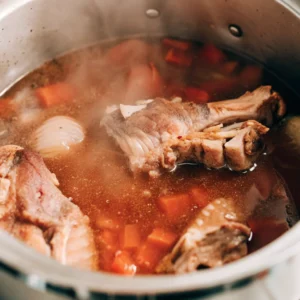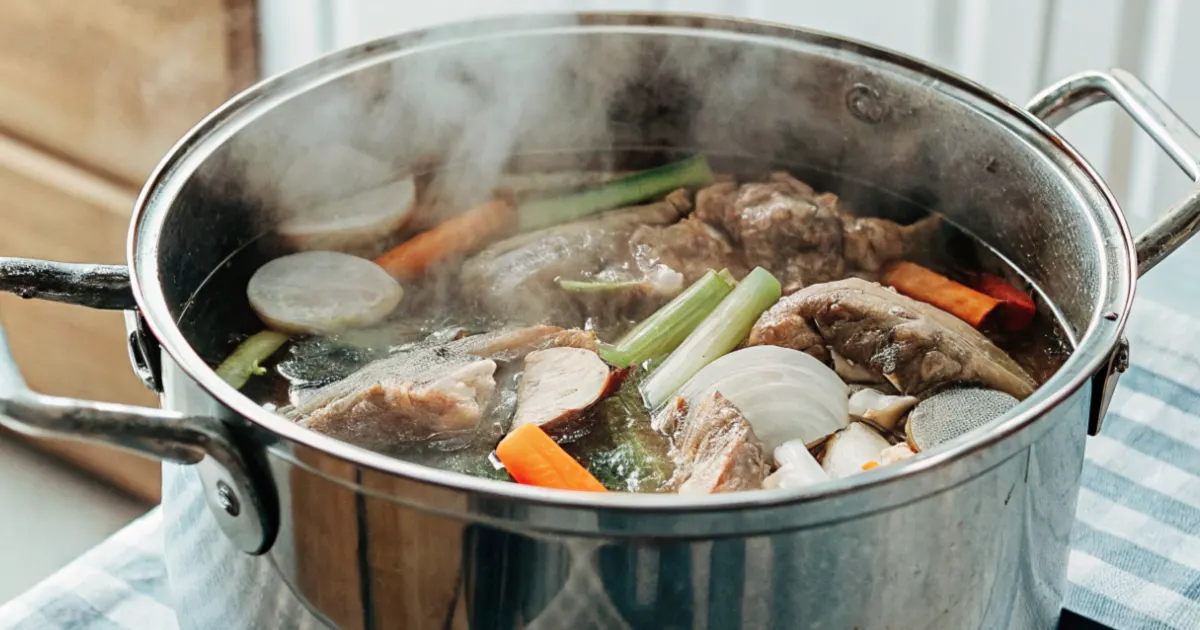Meat Stock Recipe
Meat stock is the unsung hero in so many delicious dishes. Have you ever wondered how chefs make their soups, stews, and gravies so rich and full of flavor? The secret often lies in a carefully crafted homemade stock, made from meaty bones, fresh vegetables, and aromatic herbs.
Not only does it elevate your cooking, but it also provides a nutrient-rich base for endless recipes. Best of all, making your own stock is easier than you might think! So, let’s unlock the flavor potential and bring your meals to life with this simple, yet powerful, meat stock recipe.
More meat recipe : fried deer meat – Deer Meat Meatball
Table of Contents
Key Benefits of Making Your Own Meat Stock
Making your own meat stock is a game-changer in the kitchen. Not only does it boost the flavor of your dishes, but it also offers a range of other benefits that store-bought versions can’t compete with. Here’s why you’ll want to start making your own stock:
1. Rich, Deep Flavor
Homemade meat stock is packed with a natural, savory depth that instantly elevates your soups, stews, sauces, and risottos. The long simmering process extracts all those delicious, meaty flavors from the bones and vegetables, creating a complex base that enhances any dish.
2. Health Benefits
Not only does meat stock add incredible flavor, but it’s also a nutritional powerhouse. The collagen released from the bones during cooking is beneficial for your joints and skin. Plus, it’s rich in minerals like calcium and magnesium, which support overall health.
3. Customizable to Your Taste
One of the best things about making your own stock is the ability to tailor it to your preferences. Want a more robust flavor? Simply add more herbs or let it simmer longer. Prefer a lighter broth? Reduce the cooking time or use less fatty meat. The possibilities are endless!
4. Cost-Effective
While store-bought stock can be pricey, making your own is incredibly budget-friendly. You can use leftover bones from your meals or pick up inexpensive cuts from the butcher, turning scraps into something rich and flavorful. It’s a great way to minimize food waste while getting the most out of every ingredient.
5. Versatile in Cooking
Meat stock can be used in a wide variety of recipes, from warming soups and savory sauces to braised dishes and gravies. It serves as a versatile base that can be incorporated into almost any meal, making it a must-have in your kitchen arsenal.
By making your own stock, you’re not just adding flavor you’re creating a nutritious, customizable, and budget-friendly ingredient that will transform your cooking. Ready to start? Let’s dive into the ingredients you’ll need!
Ingredients for a Flavorful Meat Stock
Now that we’ve established why homemade meat stock is such a culinary game-changer, let’s dive into the ingredients. The beauty of this recipe is that it doesn’t require any exotic or hard-to-find items. Instead, it’s all about quality basics that come together to create a rich, flavorful foundation for countless dishes. Here’s what you’ll need:
1. Meaty Bones
The bones are the star of your stock, so it’s important to choose the right ones. For a deep, rich flavor, you’ll want to use meaty bones with plenty of marrow. Some great options include:
- Beef bones (shank, neck, or marrow bones work best)
- Chicken bones (perfect for a lighter, more delicate stock)
- Pork bones (offers a subtly sweet, savory depth)
If you have leftover bones from a roast, feel free to use those—they already have flavor and can make your stock even more robust.
2. Vegetables for Balance
The vegetables you choose play a key role in balancing out the richness of the bones. Aim for a classic combination, though feel free to adjust based on your preferences.
- Onions (two medium, quartered no need to peel!)
- Carrots (two large, cut into chunks)
- Celery (two stalks, cut into pieces)
Feel free to get creative by adding a leek or parsnip to deepen the flavor profile.
3. Aromatic Herbs for Fragrance
Herbs are essential for infusing your stock with that beautiful, savory fragrance. Stick with the basics or experiment with your favorite fresh herbs.
- Bay leaves (two leaves for subtle flavor)
- Thyme (a few sprigs)
- Parsley stems (a handful, don’t waste them!)
For a bolder, more aromatic stock, consider adding rosemary or sage to the mix.
4. Whole Peppercorns
Whole black peppercorns will add just the right amount of heat to your stock. Adding them whole ensures that the pepper flavor is more subtle and melds beautifully with the other ingredients.
5. Salt
Salt is important, but you want to control it carefully. Add a pinch of salt early on, but avoid over-seasoning at the start. You’ll taste and adjust the seasoning later for the perfect balance.
6. Water
Water is the base that helps draw out all the flavor from your ingredients. You’ll want enough to fully cover the bones and vegetables by a couple of inches. This ensures everything gets properly simmered, releasing those delicious flavors into the stock.
Pro Tip:
When making stock, simmer, don’t boil. Boiling can break down the fat and cause impurities to emulsify into the stock, making it cloudy. A slow, steady simmer is the secret to a clean, clear, and flavorful broth. Keep an eye on it and skim off any foam or impurities that rise to the surface.
With these ingredients in hand, you’re all set to begin the next step: simmering everything to perfection. Let’s move on and start creating that flavorful stock!
Instructions for Making Perfect Meat Stock
Creating a rich, flavorful meat stock is a straightforward process that enhances your culinary creations. Follow these steps to craft a stock that serves as a robust foundation for soups, sauces, and more.
1. Prepare Your Ingredients
- Vegetables: Roughly chop your carrots, celery, and onions into large pieces. There’s no need for precision; the goal is to extract their flavors into the stock.
- Meat and Bones: If using larger cuts like shank or neck bones, consider breaking them into smaller sections to facilitate better flavor extraction.
2. Combine Ingredients in a Large Pot
- Place the chopped vegetables, meat, bones, herbs, and peppercorns into a large stockpot.
- Add cold water to cover the ingredients by about two inches. Starting with cold water helps draw out the flavors gradually, resulting in a richer stock.
3. Bring to a Boil, Then Simmer
- Heat the pot over medium-high heat until it reaches a boil.
- Once boiling, reduce the heat to a low simmer. Maintain a gentle simmer to prevent cloudiness in the stock.
- During the first 30 minutes, skim off any foam or impurities that rise to the surface to keep the stock clear.
4. Simmer for Several Hours
- Allow the stock to simmer for at least 3–4 hours, and up to 6 hours for a more intense flavor. The longer the simmer, the richer the stock becomes as the bones release collagen and nutrients.
- If the liquid level decreases too much, add more water to keep the ingredients submerged.
5. Strain the Stock
- Once the simmering is complete, strain the stock through a fine-mesh strainer or cheesecloth into a clean container.
- Discard the solids, as they’ve imparted their flavors to the broth.
6. Taste and Adjust Seasoning
- Taste the stock and adjust the seasoning with salt and pepper as needed.
- Since the stock has concentrated flavors, add seasonings gradually, tasting as you go.
Pro Tip:
- For a deeper, more complex flavor, consider roasting the bones and vegetables before simmering. Roast at 400°F for 30–45 minutes until they are golden and caramelized. This step adds a rich, smoky depth to your stock.
Your homemade meat stock is now ready to enhance your dishes with its robust flavor. Store it in the refrigerator for up to a week or freeze it for longer preservation. Enjoy the depth and richness it brings to your cooking!
Pro Tips and Variations for Perfecting Your Meat Stock
Making meat stock from scratch is an art, and there’s always room to elevate it further! Here are some pro tips and variations that will help you create a stock that’s truly exceptional. Whether you’re looking for richer flavor or want to switch up the ingredients, these suggestions will add that extra something special to your dish.
1. Roast Your Bones and Veggies for Extra Flavor
Before you add the bones and vegetables to the pot, try roasting them first. Roasting caramelizes the ingredients, bringing out their natural sweetness and creating a deeper, more complex flavor in your stock.
- How to roast: Preheat your oven to 400°F (200°C) and spread your bones and vegetables on a baking sheet. Roast for 30–45 minutes, or until they’re golden brown.
- This simple step will add richness and depth, making your stock even more flavorful.
2. Add Aromatics for Layered Flavors
Herbs like thyme, bay leaves, rosemary, and parsley bring freshness and depth to your stock. You can also experiment with adding garlic, ginger, or even a splash of soy sauce or vinegar for a unique twist.
- Pro Tip: Bundle your herbs in a cheesecloth or tie them with kitchen twine for easy removal later. This keeps the stock clear and avoids bits floating around.
3. Use Different Meats for Different Results
While beef or chicken bones are commonly used, you can try making stock with other types of meat like lamb, pork, or even duck for a richer, more distinct flavor profile. Each meat type brings something unique to the table, so don’t be afraid to experiment.
- Bone-in cuts: Neck bones, oxtails, or shank bones all provide excellent collagen, which makes the stock richer and thicker.
4. Consider Adding a Splash of Acidity
A small amount of acidity, like apple cider vinegar or lemon juice, can help break down the collagen in the bones, making your stock even richer in nutrients. It also adds a subtle tang that balances the deep flavors of the stock.
- How much to add: Just a tablespoon or two is enough. Add it at the beginning of the simmering process.
5. Let It Simmer Longer for More Flavor
If you’re looking for a deeper, more robust flavor, let your stock simmer for a longer period up to 6–8 hours. The longer it cooks, the more flavor will be extracted from the bones and vegetables, making it thicker and more nutrient-dense.
- Slow and steady: If you’re short on time, 3–4 hours will still give you a great result, but longer simmering leads to a stock that’s incredibly rich.
6. Skim Regularly for Clarity
As your stock simmers, you’ll notice foam and impurities rising to the surface. Skimming these off periodically will help keep your stock clear and free from any unwanted flavors, ensuring a clean, silky result.
- Skimming tip: Use a ladle or a fine-mesh skimmer to remove foam and impurities. This keeps the stock tasting fresh and pure.
Bonus Variation: Veggie-Only Stock
If you’re looking for a vegetarian alternative, consider making a veggie-only stock using mushrooms, carrots, onions, garlic, and herbs. The mushrooms, in particular, offer a meaty, umami-rich flavor that makes this plant-based stock feel indulgent. Just follow the same simmering process, and you’ll have a flavorful base perfect for soups, risottos, and sauces.
With these pro tips and variations, you can easily tailor your meat stock to suit your preferences or experiment with new flavors. The beauty of homemade stock is that it’s completely customizable, so have fun and enjoy the process!
Serving Suggestions for Your Meat Stock
Now that you’ve made a delicious homemade meat stock, it’s time to put it to good use! Whether you’re using it as a base for soups, stews, or sauces, or enjoying it on its own, there are endless ways to incorporate this rich liquid into your meals. Here are a few serving suggestions to inspire your cooking:
1. Use as a Base for Soups and Stews
A homemade meat stock is the perfect base for hearty soups and stews. Whether you’re making a classic beef stew, chicken noodle soup, or a comforting vegetable soup, meat stock adds depth and richness.
- Tip: For an extra burst of flavor, consider adding a splash of the stock at the end of cooking to finish the dish with an extra layer of depth.
2. Enhance Sauces and Gravies
Meat stock is a key ingredient in making flavorful gravies and sauces. Use it in classic dishes like beef stroganoff, chicken gravy, or a rich demi-glace. The stock’s robust flavors will elevate any sauce, making it silky and full-bodied.
- Pro Tip: Reduce the stock by simmering it for longer to concentrate its flavors before adding it to sauces or gravies. This intensifies the taste and results in a thicker consistency.
3. Make Risotto or Rice Dishes
For a rich, flavorful risotto or any rice-based dish, use your homemade meat stock instead of water. The stock will infuse the rice with savory depth, taking the dish to the next level.
- Tip: Use the stock to cook the rice, and for an added touch, stir in a little butter and Parmesan cheese once it’s cooked. The creamy texture will complement the stock’s flavor.
4. Sip It as a Simple Broth
Sometimes the best way to enjoy your meat stock is to sip it straight. Heat it up, add a pinch of salt, and serve it in a bowl as a comforting, savory broth.
- Optional Add-ins: Garnish with fresh herbs like parsley or thyme, or add a few drops of lemon juice for brightness.
5. Braise Meats
Using your stock for braising meats is a fantastic way to infuse flavor into tougher cuts of meat. Slowly cooking meats in the stock will tenderize them while allowing them to absorb all the rich flavors of the broth.
- How to: Brown your meat in a hot pan, then pour in the stock to cover the meat. Let it simmer on low heat until the meat is tender and falls apart easily.
6. Use in Mashed Potatoes or Gravy
For a unique twist on mashed potatoes or gravy, swap out some of the milk or cream with your homemade stock. The result will be a savory side dish with a layer of rich flavor.
- Tip: When making mashed potatoes, use stock to help mash the potatoes for a lighter, yet flavorful texture.
Bonus Tip: Freeze for Later Use
If you find yourself with extra stock, don’t let it go to waste! Pour it into ice cube trays or airtight containers and freeze for later use. Stock cubes are perfect for adding flavor to quick meals or using in future recipes.
With these simple and creative serving suggestions, your homemade meat stock will quickly become a staple in your kitchen. It’s versatile, full of flavor, and can be used in countless ways to enhance your cooking.
Conclusion: The Ultimate Meat Stock Recipe
Congratulations! You’ve just made a delicious, homemade meat stock that will elevate your cooking to new heights. Whether you’re using it as a base for soups, stews, sauces, or even sipping it on its own, this versatile stock will add a rich, savory depth to any dish.
Making your own stock from scratch may take a little time, but the flavor payoff is well worth the effort. Plus, the beauty of homemade stock is that you can control the ingredients and flavors to suit your personal taste. It’s the secret ingredient that professional chefs swear by, and now, you can enjoy it in your kitchen too!
Why Make Homemade Meat Stock?
- Better Flavor: Homemade stock has a depth of flavor that store-bought versions can’t match.
- Healthier: You can control the amount of salt, and the collagen from bones can provide added nutrients.
- Cost-Effective: It’s a great way to use leftover bones and vegetable scraps, making it both eco-friendly and budget-friendly.
Ready to Experiment?
Now that you’ve got the basics down, feel free to experiment with different meats, vegetables, and seasonings to create your own signature stock. Roasting the bones, adding unique herbs, or experimenting with longer simmering times can all help create different flavor profiles for various dishes.
Storage Tips:
- Refrigerate: Keep your meat stock in an airtight container in the refrigerator for up to 1 week.
- Freeze: For longer storage, pour the stock into ice cube trays or large containers and freeze. These stock cubes are perfect for adding instant flavor to any meal.
By making your own meat stock, you’re not only bringing an amazing flavor boost to your dishes but also connecting to a rich culinary tradition. So, take pride in your stock-making skills and enjoy all the incredible meals you’ll create with it! Happy cooking!
Recipe Recap: Homemade Meat Stock
Recipe Details:
- Prep Time: 15 minutes
- Cook Time: 3–8 hours (depending on desired richness)
- Total Time: 3–8 hours
- Servings: 8–10 servings
- Calories: 50–80 calories per serving (varies based on ingredients used)
Nutrition Information (Per Serving):
- Calories: 60
- Fat: 3g
- Protein: 7g
- Carbs: 1g
- Fiber: 0g
- Sodium: 150mg (adjustable depending on salt added)
- Cholesterol: 20mg
Note: The nutrition values may vary slightly depending on the type of meat used and how much fat is skimmed off the top after cooking.
Categorize the Recipe:
- Course: Soup/Broth, Sauce Base
- Cuisine: American, French, Global
- Diet: Keto, Paleo, Low-Carb, Gluten-Free
- Method: Simmering, Stovetop
- Keyword: Homemade Meat Stock, Beef Stock, Chicken Broth, Bone Broth, Savory Stock
- Skill Level: Beginner to Intermediate
This homemade meat stock recipe offers a delicious, nutrient-packed foundation for countless dishes, from comforting soups and stews to rich sauces. Whether you’re using it to enhance your meals or sipping it straight, this versatile stock will bring deep, savory flavors to every dish.

Meat Stock Recipe
Ingredients
- Meaty Bones Beef bones (shank, neck, or marrow bones work best)Chicken bones (perfect for a lighter, more delicate stock)Pork bones (offers a subtly sweet, savory depth)
- Vegetables for Balance The vegetables you choose play a key role in balancing out the richness of the bones. Aim for a classic combination, though feel free to adjust based on your preferences.
- Aromatic Herbs for Fragrance Herbs are essential for infusing your stock with that beautiful, savory fragrance. Stick with the basics or experiment with your favorite fresh herbs.Bay leaves (two leaves for subtle flavor)Thyme (a few sprigs)Parsley stems (a handful, don’t waste them!)
- Whole Peppercorns Whole black peppercorns will add just the right amount of heat to your stock. Adding them whole ensures that the pepper flavor is more subtle and melds beautifully with the other ingredients
- Salt Salt is important, but you want to control it carefully. Add a pinch of salt early on, but avoid over-seasoning at the start. You’ll taste and adjust the seasoning later for the perfect balance.
- Water Water is the base that helps draw out all the flavor from your ingredients. You’ll want enough to fully cover the bones and vegetables by a couple of inches. This ensures everything gets properly simmered, releasing those delicious flavors into the stock.
Instructions
- Prepare Your IngredientsVegetables: Roughly chop your carrots, celery, and onions into large pieces. There’s no need for precision; the goal is to extract their flavors into the stock.Meat and Bones: If using larger cuts like shank or neck bones, consider breaking them into smaller sections to facilitate better flavor extraction.
- Combine Ingredients in a Large PotPlace the chopped vegetables, meat, bones, herbs, and peppercorns into a large stockpot.Add cold water to cover the ingredients by about two inches. Starting with cold water helps draw out the flavors gradually, resulting in a richer stock.
- Bring to a Boil, Then SimmerHeat the pot over medium-high heat until it reaches a boil.Once boiling, reduce the heat to a low simmer. Maintain a gentle simmer to prevent cloudiness in the stock.During the first 30 minutes, skim off any foam or impurities that rise to the surface to keep the stock clear.
- Simmer for Several HoursAllow the stock to simmer for at least 3–4 hours, and up to 6 hours for a more intense flavor. The longer the simmer, the richer the stock becomes as the bones release collagen and nutrients.If the liquid level decreases too much, add more water to keep the ingredients submerged.
- Strain the StockOnce the simmering is complete, strain the stock through a fine-mesh strainer or cheesecloth into a clean container.Discard the solids, as they’ve imparted their flavors to the broth.
- Taste and Adjust SeasoningTaste the stock and adjust the seasoning with salt and pepper as needed.Since the stock has concentrated flavors, add seasonings gradually, tasting as you go.
Notes
- For a deeper, more complex flavor, consider roasting the bones and vegetables before simmering. Roast at 400°F for 30–45 minutes until they are golden and caramelized. This step adds a rich, smoky depth to your stock.
- The nutrition values may vary slightly depending on the type of meat used and how much fat is skimmed off the top after cooking.
- If you find yourself with extra stock, don’t let it go to waste! Pour it into ice cube trays or airtight containers and freeze for later use. Stock cubes are perfect for adding flavor to quick meals or using in future recipes.
FAQ
Making your own meat stock can raise a few questions, especially if you’re new to the process. Don’t worry, though! I’ve gathered some of the most common queries to help guide you along the way and ensure your stock turns out perfect every time.
Can I use any type of meat for stock?
Absolutely! While beef, chicken, and pork are common choices, you can use any type of meat, including lamb, turkey, or duck. Each type of meat will impart its own unique flavor to the stock. For a richer stock, consider using bones with a bit of meat still attached, as this will release more flavor and collagen.
Pro Tip: Oxtails and beef shanks are fantastic for creating a gelatinous, full-bodied stock.
How long should I cook the stock?
The length of time you simmer your stock depends on how concentrated and rich you want it. For a classic, flavorful stock, cook it for 3–4 hours. If you’re after a deeply rich, gelatinous stock, feel free to simmer for up to 6–8 hours. The longer the cook time, the more the flavors develop.
Tip: Keep the heat low and let it simmer gently to avoid clouding the stock.
How do I store leftover stock?
Storing homemade stock is easy! If you plan to use it within the next few days, store it in an airtight container in the fridge. For longer storage, freeze the stock in ice cube trays or large containers. Frozen stock cubes are perfect for adding flavor to dishes like soups, risottos, and sauces at a moment’s notice.
Pro Tip: Label your stock with the date so you can easily keep track of how long it’s been stored.
Can I use meat stock in vegetarian dishes?
While traditional meat stock is made with animal bones and meat, you can certainly use a vegetable-based stock as a vegetarian alternative in most recipes. That said, if you’re looking for a meaty flavor for vegetarian dishes, you can enhance a veggie stock by adding mushrooms, seaweed, or miso for a savory umami boost.
How can I make my stock clearer?
A clean, clear stock can be achieved by skimming off any foam or impurities that rise to the surface during the simmering process. Use a fine-mesh strainer or ladle to remove the foam. You can also strain the stock through cheesecloth for an even clearer result.
Tip: To clarify a cloudy stock, you can also use egg whites to “clear” it by adding them to the simmering liquid, which will bind with the impurities.
How do I know when my stock is done?
You’ll know your stock is ready when it has a deep, rich color and a robust, savory flavor. The stock should also be thickened, especially if you’ve used bones with a lot of collagen, like oxtails or beef shanks. If your stock isn’t as thick as you’d like, simply continue simmering to concentrate it further.
Can I freeze stock with the fat on top?
Yes! In fact, the layer of fat on top of your stock can act as a seal, keeping the stock fresh for longer in the freezer. You can also skim off the fat once the stock has cooled if you prefer a leaner version. Either way, freezing stock with or without fat is perfectly fine.
What is the difference between meat broth and meat stock?
The main difference between meat broth and meat stock comes down to ingredients and cooking time:
Meat Stock is made mostly from bones (sometimes with meat) and cooked for a long time (3-8 hours). It’s thicker and richer because the bones release gelatin and minerals.
Meat Broth is made from meat (and sometimes bones) and cooked for a shorter time (1-2 hours). It’s lighter and thinner since it mainly extracts flavor from the meat.
In short:
Stock = Bones + Long cook = Rich, thick, gelatinous.
Broth = Meat + Short cook = Light, thinner, meat-flavored.
Is meat stock healthy?
Meat stock, particularly when made from bones, is considered a nutritious addition to your diet. It contains essential nutrients such as collagen, electrolytes, and various amino acids.
WebMD
Consuming meat stock may offer several health benefits:
Digestive Health: The gelatin in meat stock supports healthy digestion by attracting and holding liquids, which helps foods move through your gut more easily.
Joint Support: The collagen extracted from bones during the simmering process can contribute to joint health by supporting cartilage.
Cleveland Clinic Health
Skin Health: Collagen in meat stock may improve skin elasticity and hydration, potentially reducing the appearance of wrinkles.
However, it’s important to note that while meat stock can be a healthy component of your diet, it should be consumed as part of a balanced diet. The nutritional content can vary based on the ingredients used and preparation methods. Additionally, if you have specific health conditions or dietary restrictions, it’s advisable to consult with a healthcare professional before making significant changes to your diet.
With these FAQs, you’re now equipped to tackle the stock-making process with confidence! Don’t hesitate to make adjustments based on your preferences or specific recipes. The beauty of homemade meat stock is that it’s versatile, customizable, and packed with flavor. Enjoy the process and the incredible dishes you’ll create with it!
There are no reviews yet. Be the first one to write one.







